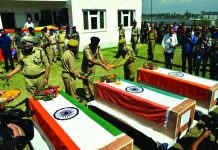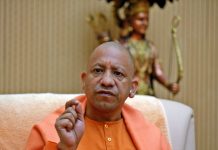The state’s results show how Nitish Kumar split low-caste Hindu and Muslim votes to beat Lalu Yadav at his own game, says Ajit Sahi

Photo: AP
NO FORECAST could predict the sweep of the final score. Nitish Kumar’s alliance: 32; Lalu Yadav’s alliance: 4. Game, set and match, Nitish. Just how did Kumar, the mild-mannered chief minister of Bihar, never known for political cunning, make mincemeat of Lalu Yadav, Bihar’s iconic backward caste leader, one who has ruthlessly decimated many a mass leader in his 35-year career?
The answer lies as much in Kumar’s crafty politics of caste and religion as in his electoral plank of development, projected in the name of the 24-month rule of Bihar by his National Democratic Alliance (NDA), which includes the BJP.
“This election was a hurricane, just like in 1977,” an ecstatic Ram Sundar Das, a leader of the Nitish Kumar-led Janata Dal-United (JD-U), told TEHELKA. His allusion is to the historic election of 32 years ago that swept former Prime Minister Indira Gandhi out of power after the infamous Emergency. Das is the surprise victor over dalit giant, Ram Vilas Paswan, in the Lok Sabha constituency of Hajipur, from where Paswan had made his Lok Sabha debut in 1977 and retained it eight out of nine times since then — losing it only last week.
This election was a hurricane, just like in 1977’, says Ram Sundar Das of the JD-U
For Das, who joined the JD-U just before last month’s elections after years in the political wilderness, the taste of victory is sweeter. He had lost the chief minister’s job to Lalu in 1990 after their party had won the most seats in Bihar’s Assembly, an event that heralded Lalu’s 15-year rule over Bihar until Nitish ended Lalu’s wife, Rabri Devi’s reign as chief minister in 2005.
The results of this year’s Lok Sabha elections in Bihar are historic in many ways. A split among Lalu’s caste brethren saw many Yadavs desert him and the candidates of his Rashtriya Janata Dal (RJD). (Ironically, besides Lalu, none of the three other RJD MPs elected last week are Yadavs. They are all Rajputs.) For example, in Buxar, a constituency adjoining Uttar Pradesh, Lalu and his wife failed to woo the Yadavs despite aggressive campaigning. Although their nominee won, his rival, Daddan Singh ‘Pahalwan’, got more than 1.2 lakh votes in the Yadav-dominated region.
Similarly, in many constituencies, dalits appeared to have rejected Paswan and the candidates of his Lok Janshakti Party (LJP). Obviously, Lalu and Paswan failed to “transfer” their “vote-banks” to each other as they had hoped to do when they deserted the Congress and allied with each other after the elections were called. Stunningly, Paswan lost even in Raghopur, a Yadav-dominated segment of Hajipur that Rabri Devi represents in the Bihar Assembly.
The Muslim vote has made the JD-U upbeat about the 2010 Assembly elections
On the other hand, large numbers of Muslims voted for the JD-U, overcoming their loathing for the party’s key ally, the BJP. In Bhagalpur, the Muslims even voted for the BJP’s Shahnawaz Hussain, a former central minister, giving him a win. In fact, the Muslim vote has made the JD-U upbeat about the Assembly elections due in October 2010. “This time, some Muslims did not vote for the NDA because we projected LK Advani as prime minister,” says Rajya Sabha MP and JD-U spokesman, Shivanand Tiwari. “But for the Assembly, they will vote for us with both hands.”
THAT THE Muslim vote has shifted was evident in the Phulwarisharif Assembly segment of the Pataliputra Lok Sabha constituency. The Muslims here voted for JD-U nominee Ranjan Prasad Yadav, who spectacularly defeated Lalu Yadav. Lalu lost in four out of the six Assembly segments of Pataliputra, with the Yadav votes going, quite obviously, to his rival. He scraped through to the Lok Sabha from another seat, Saran. Another strategy that paid off for Nitish Kumar was focussing on the “extremely backward castes”, or EBCs, which account for over 20 percent of Bihar’s eight crore people. “This was a social polarisation that tremendously helped the NDA,” says Patna-based political commentator Arun Kumar Ashesh. Nitish Kumar’s government has wooed the EBCs, which include some 100 poorest sub-castes, by running separate schemes for their economic uplift, including a 20- percent reservation for them in village panchayats (See TEHELKA cover story “Is This Man Going To Surprise Everyone”, May 16, 2009).
Similarly, Kumar created a separate category for 18 sub-castes of dalits, calling them “Maha Dalits”, and ran economic schemes for them specifically. So severe was the rejection of the RJD-LJP by the lower-caste Hindu and Muslim voters that the LJP was decimated in the six districts of northeast Bihar, which are collectively referred to as the “Kosi belt”, named after a river there. The Yadavs, Muslims and dalits — the traditional voters of Lalu and Paswan — dominate this belt.
[box]
CRIMINALS AND THEIR RELATIVES WHO LOST
CONGRESS
Ranjita Ranjan
Wife of Pappu Yadav Supaul
INDEPENDENT
Shanti Priya
Mother of Pappu Yadav Purnea
RJD
Heena Shahabuddin
Wife of Mohammad Shahabuddin Siwan
CONGRESS
Lovely Anand
Wife of Anand Mohan Sheohar
LJP
Veena Devi
Wife of Suraj Bhan Singh Nawada
JD-U
Munna Shukla
Vaishali
LJP
Rama Singh
Arrah
JD-U
Prabhunath Singh
Maharajganj
LJP
Zakir Khan
Araria
RJD
Taslimuddin
Kishanganj
CONGRESS
Sadhu Yadav
West Champaran
BSP
Anwarul Haq
Sheohar
RJD
Jay Prakash Yadav
Banka
[/box]
There may be a grain of truth in the belief that Lalu and Paswan made a mistake by breaking away from the Congress. “In more than 20 constituencies, the total number of votes polled by the candidates of the Congress and the RJD-LJP exceeded those gained by the NDA candidate,” says political commentator Srikant in Patna. “Had the Congress and RJD-LJP stayed together as the United Progressive Alliance (UPA), it would have been tougher for the NDA.” At many places, the Congress attracted the Muslims in droves, a trend seen in Uttar Pradesh, West Bengal, Andhra Pradesh and Maharashtra, thus splitting them from the RJD-LJP, for whom the Muslims voted earlier.
JD-U spokesperson Tiwari, however, pooh-poohs the claims that a combined UPA could have challenged the NDA. “The people here are so angry with Lalu- Paswan,” he says, “that the Congress wouldn’t even have got the few votes it did in Bihar had it allied with them.” In some 18 seats, the NDA nominee got more votes than the combined vote share of the Congress and the RJD-LJP. According to Tiwari, Lalu lives in the “old world”, believing that caste and not development decided votes. Widely credited for social engineering during his rule from 1990 to 2005 that made the backwards castes aware of their political clout, Lalu is ironically seen as responsible for their desertion this time.
It is said that once awakened, Bihar’s backward castes came to expect a much better deal from life than Lalu could offer during his and his wife’s governments. “Poor Biharis began to go out of the state and desire the levels of development they saw there,” says Srikant. Agrees Ashesh, “Nitish’s developmentoriented politics is the logical next step of Lalu’s caste politics of the last decade.”
If there is any decimation, however, in Bihar worse than Lalu’s or Paswan’s, it is of the criminal class (see box). Says Bihar’s Home Secretary Afzal Amanullah: “I can assure you that you are not going to see these criminals or their wives and mothers in Parliament for a long time.”
ajit@tehelka.com













